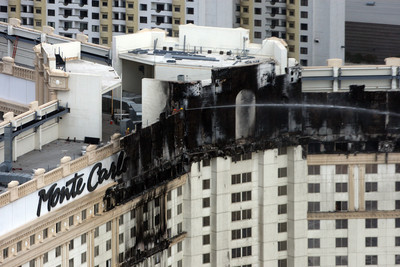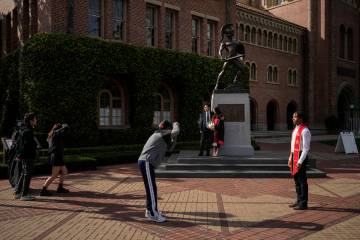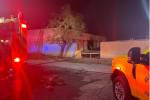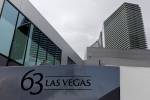Foam used along rooftop deemed safe for high places
The rooftop of the Monte Carlo contains a flammable rubberized "membrane" and its facade contains foam, a flammable substance allowed in high-rise construction.
Clark County Fire Department Capt. Warren Whitney, who described the fire as "initially not that bad," said he was surprised at how rapidly it progressed across the building's foam structure.
"There was a slight breeze that was helping it to progress," he said.
Construction plans for the Monte Carlo, on file in the county's building division, show that the facade near the building's roof line is a panel assembly system that contains foam, county spokeswoman Stacey Welling confirmed.
"This is a system in which you have foam wrapped in fiberglass and then again encapsulated in a cementatious material, like stucco -- a very thin-coat material," said Clark County Development Services Director Ron Lynn. "If the fire got behind that material, then it allows it to spread."
He said he was investigating whether the fire did get behind that material coating.
Clark County building codes, revised every three years, continually make the use of foam more strict, Lynn said. The Monte Carlo foam met 1991 building codes, which were more lenient about foam thickness.
Foam pieces damaged in Friday's fire will have to be replaced with foam that meets current standards. But county officials will take that effort a step further and discuss replacing all of the foam on the building, Lynn said.
Foam is a "very common" product that can be molded and sculpted, said Terry Taylor, a fire investigator in Northern Nevada who also has served as state fire marshal for Nevada and California.
Such foam products come in sheets or blocks that resemble Styrofoam. They are used on upper levels of a high-rise building to match the architectural look of the lower levels, which usually are constructed of authentic materials such as stone or brick, the investigator explained.
According to Taylor, the International Building Code considers the material safe to use in high locations.
Also, the outer rubberized "membrane" of a typical high-rise building's roof is flammable and gives off thick, black smoke when burned, he said. But the membrane is only one layer of the "sandwich" of materials, which together are considered a roof assembly and must be able to resist fire.
The membrane's purpose is to prevent water leaks. Other layers of a commercial roof assembly include steel and concrete, which prevent passage of fire from one side of the assembly to the other.
Other flammable materials such as wood may be present on a commercial high-rise building's roof, he added. Wooden blocks, for example, may be used to support gas lines so that "those pipes don't rub on the membrane. They keep it from being penetrated through vibration," Taylor said.
The role that rooftop workers played in the Monte Carlo fire is still unclear, but legal codes cover how to weld safely.
Safe practice is for welders always to have a fire extinguisher nearby for use should their equipment drop hot "slag," which can ignite materials, Taylor said.
After a job is completed, welders are supposed to stand by at the work site for 30 minutes to detect whether a stray spark has landed in a concealed space.
Some jurisdictions require workers to obtain a "hot work" permit when a job will require welding, soldering or brazing. All are techniques for joining metal pieces. Clark County does offer such a permit, according to Welling, who was researching its requirements and relevance to the fire.
No one from the Clark County Fire Department's fire prevention bureau responded to interview requests Friday. Its managers were either on the scene of the hotel fire or out of town.
Contact reporter Joan Whitely at jwhitely@reviewjournal.com or (702) 383-0268. Contact reporter Lawrence Mower at lmower@reviewjournal.com or (702) 383-0440.
Multimedia Monte Carlo three-alarm fire video Displaced Monte Carlo guests moved to MGM View the slideshow AP Video • Send your photos of the Monte Carlo fire to the Review-Journal.




























